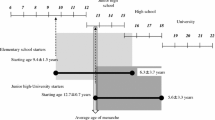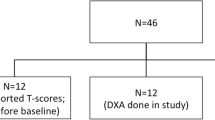Abstract
The aim of this study was to investigate any differences in bone mass at different sites between young adults subjected to a high physical activity and a group of young adults with a low level of physical activity. In addition, we compared the relationship among bone mass, muscle strength, and body constitution in these two groups. The reference group consisted of 20 men, age 24.6 ± 2.3 years, not training for more than 3 hours per week. The ice hockey players consisted of 20 players, age 23.4 ± 4.9 years, from an ice hockey team in the second highest national Swedish league, training for about 10 hours per week. The groups were matched according to age, height, and weight. Areal bone mineral density (BMD) was measured in total body, head, humerus, spine, pelvis, femur, femoral neck, Ward's triangle, trochanter, femur diaphysis, proximal tibia, and tibia diaphysis using dual energy X-ray absorptiometry. BMD was significantly higher in the total body (8.1%), humerus (11.4%), spine (12.7%), pelvis (12.4%), femoral neck (10.3%), femur (7.4%), proximal tibia (9.8%), and tibia diaphysis (7.5%) in the high activity group. Fat mass was significantly lower in the high activity group (18.7%). The high activity group also had a significantly higher lean body mass (5.4%) and a significantly higher isokinetic muscle strength of the quadriceps muscle compared with the reference group. In the reference group, there was a general strong independent relationship between muscle strength of the thigh and all BMD sites, except for the head, tibia diaphysis, and proximal tibia. Furthermore, in the same group, body mass index (BMI) independently predicted pelvis BMD. On the contrary, in the high activity group, muscle strength did not predict any BMD site at all. In the same group, body constitutional parameters (weight, height, and fat mass) independently predicted pelvis BMD, and BMI was shown to be an independent predictor of humerus BMD. The differences in BMD between the groups seem to be site-specific and may be associated with the type and magnitude of loading during off season training and preferentially during ice hockey. High physical activity seems to weaken the relationship between BMD and muscle strength. Hence, impact forces may be of greater importance in regulating bone mass than muscle strength in itself in highly trained athletes.
Similar content being viewed by others
Author information
Authors and Affiliations
Additional information
Received: 15 October 1997 / Accepted: 1 November
Rights and permissions
About this article
Cite this article
Pettersson, U., Nordström, P. & Lorentzon, R. A Comparison of Bone Mineral Density and Muscle Strength in Young Male Adults with Different Exercise Level. Calcif Tissue Int 64, 490–498 (1999). https://doi.org/10.1007/s002239900639
Published:
Issue Date:
DOI: https://doi.org/10.1007/s002239900639




